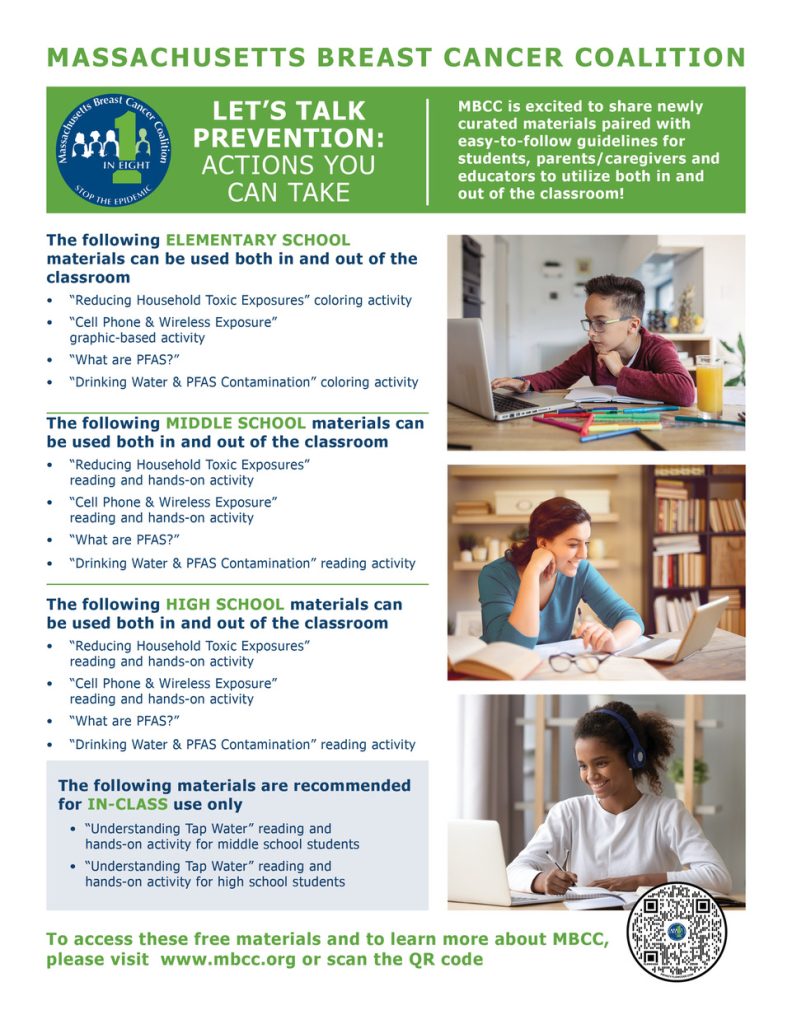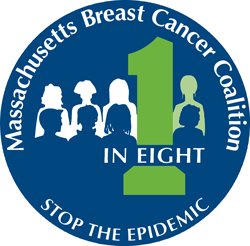If you have been searching for free educational resources, you’ve landed in the right place! During these unprecedented times, Massachusetts Breast Cancer Coalition (MBCC) is pleased to provide materials for educators and students looking to enhance our new “normal” of teaching and learning from home, in the classroom, or in a hybrid model of the two.
The Let’s Talk Prevention: Actions You Can Take (LTP) environmental education program was initially designed as stand-alone classroom modules designed to supplement current science, health, and environmental studies curriculums by providing real-world application of scientific content knowledge. This program is an extension of MBCC’s award-winning Let’s Talk Prevention: Reducing Toxic Exposures community education program and tour that informs communities across the Commonwealth about the environmental risks of breast cancer and other diseases.
To read what teachers have to say about the Program, please click here.
Now, our LTP environmental education program has been enhanced with modified guidelines and new age-appropriate activities that can be accessed and completed by elementary, middle, and high school students both in and out of the classroom.

Below, you will find information about each of our modules. To access these materials, please click on the download button which will take you to a brief survey. The materials, including the modified guidelines for remote learning, will then be sent to the e-mail address provided in the survey. Please direct any questions about these modules to info@mbcc.org.
Module 1 – Reducing Household Toxic Exposures
This module, developed in partnership with Silent Spring Institute helps students learn:
- Classes of chemicals commonly exposed to in their homes and sources.
- Existing evidence of harm from exposures, including how chemicals disrupt the endocrine system.
- About “windows of susceptibility,” or periods of development during adolescence where they are more vulnerable to the effects of toxic exposures.
- How chemicals are regulated in the U.S. and alternative models for protecting public health.
- How to reduce their toxic exposures.
- How to graph and interpret survey data and then synthesize it in report form.
The curriculum is hands-on and aligns with the importance that curriculum standards such as Next Generation Science Standards have placed on skills such as planning and carrying out investigations, analyzing and interpreting data, and communicating information.
Module 2 – Understanding Tap Water
This module was developed in partnership with the PROTECT Center at Northeastern University and covers the basics of drinking water sources, issues related to safe drinking water access, different sources of contamination, and contaminants in drinking water. It also reflects on some current cases dealing with these issues, such as lead in tap water in Flint, MI. The hands-on part of this module includes an introduction to some of the basic water quality parameters, analysis of tap water, data evaluation, and understanding of the public water supplier’s annual report on water quality.
*Due to the nature of this module, MBCC recommends this activity be completed by middle and high school students in the classroom setting only.
The module is designed to help students:
- Understand the challenges of safe drinking water access and the systemic nature of the water issues.
- Learn about water contaminants and how it can affect your health (an example of lead).
- Learn to sample and test water with simple, cost-effective kits.
- Learn about water testing data reports and how to read and understand them.
For a list of suggested materials needed for this unit, please click here.
Module 3 – Cell Phone and Wireless Exposure
This module was developed in partnership with Environmental Health Trust and helps students to understand:
- Radiofrequency radiation exposure (RF) from cell phones and wireless devices
- The health impacts of daily RF exposure and ways to reduce one’s exposure
- Other forms of electromagnetic radiation
Module 4 – What are PFAS?
This module was developed in partnership with Silent Spring Institute and helps students to understand:
- The health concerns linked to PFAS (per- and poly-fluoroalkyl substances)
- Products that contain PFAS
- How PFAS persist and proliferate through the environment
- How to reduce PFAS exposure
Module 5 – Drinking Water and PFAS Contamination
This module was developed in partnership with Pete Sampou, Ph.D., Environmental Science teacher, Sturgis Charter School, and Ella Sampou, environmental advocate, and helps students to understand:
- The health concerns linked to PFAS (per- and poly-fluoroalkyl substances)
- Provides case studies on large-scale community contamination
